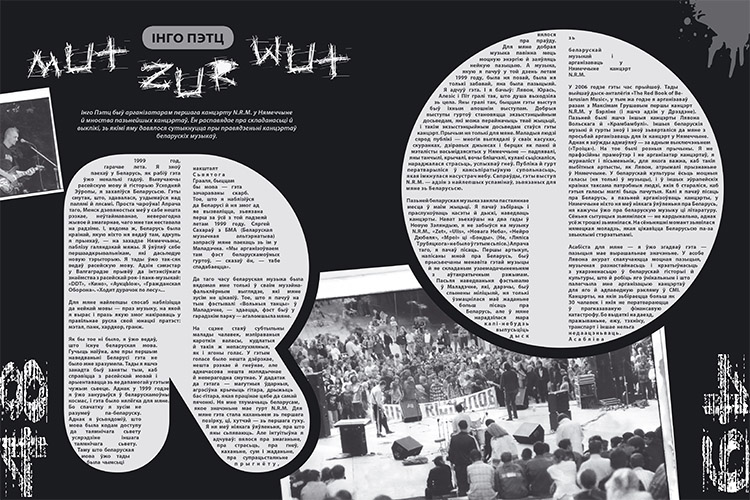
Аўтар: Volha Bubić, 21/07/2015 | ART Cult Aktivist project
«ANATOMIA. PERFECT BODY»: FINDING ANSWERS WHEN SEARCHING
This summer unexpectedly turned out extremely rich in interesting exhibitions the contemporary artists hold both on private and state platforms of the capital. Just a couple of days ago at Ў Gallery of Contemporary Art the group exhibition «The Dimension of Emptiness» opened, being another example of «АRТ-SOC-LAB» project activities. Maksim Bahdanovič Literary Museum positively surprises with its courageous cooperation with contemporary art ( project «All that is solid dissolves in the air»). And the Center of Contemporary Art not for the first time welcomes in its halls Dzina Daniłovič’s long-term project «Anatomia».

A fragment of Taciana Lisoŭskaja’s project «Dolce e vita»,
exhibited at the show «Anatomia. Perfect Body»
Corporeality problems is a direction in Dzina Daniłovič’s curatorial activities that is far from being brand new. The first group exhibition «Аnatomia» was shown at Viciebsk art-spaces in March 2013 gathering together the works of 18 artists. Today, three years later, more artists take part in it, and the number of the Center of Contemporary Art rooms with the photographs, video and installations exhibited in them now reaches the figure of 11. And if in terms of her debut show Dzina complained about difficulties in finding artists who would be eager to show their works, when observing the variety of the projects on the current display one does not have any doubts about the lack of the names.
However, «Аnatomia» has expanded not only in scale, but also in quality. And what leaves us mostly pleased is the appearance of some artists who are finally beginning to understand that the suggested topic supposes not merely photographing naked women or «a boy of whose body you can see it at all» [1].
In this regard, actually following the distinction suggested by the prominent French researcher André Rouillé, the photoprojects of «Аnatomia-3» can be roughly divided into two groups. Those where photography is still presented as an old-fashioned «photographie-document», and those where it reveals other, indirectwaysof accessing things, facts and events: moving from «a copy [of the reality] to its map, from an ideal of the truth and closeness – to the endless game of getting farther and closer» [2]. Unfortunately, the first group still includes a big number of projects where the spectator is invited together with the photographers to enjoy the literal approach to the decoding of the issue of «perfection», that is to look at the pictures of undoubtedly beautiful naked bodies. The bodies that in most cases belong to young women. And if the presence in the exposition of the naturalistic works of the Polish photography classic Zbigniew Dlubak made in the 1970-1974s can be explained by the curator’s desire to give a more complete coverage of the topic, then the reasons of the use of this synonymous and absolutely irrelevant visual language in the works of a young contemporary photographer Andrej Karačun are unclear.The act of «body comprehension» the photographer refers to in the title of his project does not actually occur.

A fragment of Andrej Karačun project «Some of the body comprehension practices»,
exhibited at the show «Anatomia. Perfect Body»
For obvious reasons, it seems logical to give a closer look at the projects that fall into the category of «photographie-expression» – there we would surely locate the series made by Taciana Lisoŭskaja, Siarhiej Ždanovič, Alena Pratasievič and Siarhiej Kažamiakin (Sergey Kozhemakin).
Both the project made by a designer and photographer from Vitebsk Taciana Lisoŭskaja «Dolce e vita» and Siarhiej Ždanovič’s three works from the series «Меtаmorphing» make use of inanimate objects (toys) as a tool of criticism of the «perfect body» concept. Namely, the projects are close in their keen interest in plastic Barbie dolls, which, as noted in the fundamental study «The Hollow Woman: inside and outside of the Barbie world» by the writer Linor Goralik are a «tangle of the completely not toy issues: consumerist society, gender self-determination, globalism, ethnic and racial hatred, contemporary pedagogy, single-parent families, pop culture perception, socialization of the individual, the fear of death — in short, everything that today forms a circle of the most topical and most painful problems of human society».[3]
Certainly, the Belarusian authors are not the innovators in conceptual games with dolls. In contemporary photography Barbie is a very popular character, inspiring artists to sometimes rather weird ideas. It is enough to recall Mariel Clayton’s scary project that reveals sadistic inclinations of the American beauty icon, a series of portrait-collages made by Sheila Pree Bright or ironic theatrical mise en scenes with dressed up characters in «Fallen Princess» and «In the Doll House» by Dina Goldstein.
The games Taciana Lisoŭskaja and Siarhiej Ždanovič play with their dolls, in the absence of explanatory curatorial or artists’ texts do not appear to be so clear and readable as the ones we observe in the projects made their foreign colleagues. However, the emotions and thoughts they evoke are strong and multi-layered. Thus, the Viciebsk photographer definitely creates in her pictures optical illusions related to the perspective and scale of the dolls, thereby suggesting us to think about the inadequacies between society demands and mass culture to the beauty canons and the human body «perfection» in the contemporary world.
The masque frequently found in Taciana’s photographs also indirectly drives to this conclusion — what if not for the blind imitation of artificial ideals the crowd of adherents of the glamour world is to be blamed?
Due to their large scales and frontal composition simplicity, Siarhiej Ždanovič’s works look laconic and frightening. Anthropomorphism, naturally embedded in the way any toy looks like, in this author’s project is shown as the absolute. Defenseless immobility in the unnatural pose of the headless («perfect») body of the doll, the eyeless plastic Piglet character, Disney princesses in cutesy postures with the ugly «prostheses» under their skirts instead of plastic legs. What is hidden behind those pretty pictures of the ideal? Looking at the «Меtаmorphing» triptych the audience finds the answers to this question at the level of the unconscious: it is fear, hopelessness, the absence of the way out when following the false principles of the «Barbie World».
Another worthy project of «Anatomia-3» is a visual research of the materials found on the «Ebay» resource, conducted by the photographer Alena Pratasievič. In the course of six months she had been looking through a photo section tagged as #Perfect Body, accumulating her own digital archive of small discoveries from around the world. It resulted in a photo-store, with contains more than 200 images, some of which were included in the exhibition at the Center of Contemporary Arts.

A fragment of Alena Pratasievič project «#Perfect Body»,
exhibited at the show «Anatomia. Perfect Body»
This is how the photographer herself describes the purpose of her conceptual collection: «The compilation of this archive mattered to me solely as a research interest, I did not aim at getting any typology, a visual diagram or a classification — to me it was more important to understand why people tag this or that photography as „perfect body“, to see the criteria they use when defining a body as perfect». The findings, one could make when observing Alena Pratasievič’s collection, perfectly fit the concept of contemporary understanding of beauty as a «trial» presented in the monumental work «A History of Beauty: The Body and the Art of Embellishment from the Renaissance to Nowadays» by the Professor of the University of Paris V, Georges Vigarello. The specialist in the field of representation and cultural history of body believes that the current stage of culture and society development is characterized by a high relevance of individuality that became the foundation of our contemporary world:
«Personality is „defined by his/her appearance“, as the sociologist Alain Ehrenberg argues, and solely by it: what the person demonstrates at the „body“ level, becomes as important as what (s)he says. Hence, the excessive zeal in an effort to „show“ themselves off, the visible part one’s „self“, one’s investment into beauty in order to manifest the integrity of the self». [4]
Speaking of «investment into beauty», Georges Vigarello means a series of «tests» that today’s people are willing to subject themselves to in order to achieve the ideals actively transmitted through television and music. Those are all kinds of diets in vogue, the craze for fitness and dance, the growing popularity of gyms. The strong position among the main criteria of body’s beauty is taken by eroticism and functional appearance. And it is the illustration of these traits that we see in the material found by Alena Pratasievič’s on the global network.

A fragment of Alena Pratasievič project «#Perfect Body»,
exhibited at the show «Anatomia. Perfect Body»
Two extremely interesting projects should be quoted as the statements on the perfect body, which clearly articulate the conceptual aspects of the problem. They were made by the «classics» of the Belarusian photography — Siarhiej Kažamiakin («In Search of the Ideal Body») and Ihar Saŭčanka («Krzyżanowski’s Assumption»). The first combines the elements of visual material and installation — convex Braille letters. When replacing with them the familiar «vision» of «the ideal», the author invites the viewer to answer the question: «Is any visibility really credible?… Can we explain when standing in front of paintings, sculptures and photographs that capture embellished, idealized, and sometimes also mutilated bodies, why we persist in their depiction?». When we accept the rules proposed by the photographer, we can try to rethink the popular notions of beauty and the ideal (accidentally or not, but in the same room, just behind us, there are Andrej Karačun’s and Alena Pratasievič’s series), triggering tactile sensations as a way to comprehend them.
What, then, remains of the «ideal»?
The latter project is presented as a smoothly flowing paragraph in the course of the hall’s space «decoding» that follows Siarhiej Kažamiakin’s open dialogue experiments with the audience. «Krzyżanowski’s Assumption» uses exclusively text medium of information presentation, and the concept of the project can be surely described as the culmination of «Anatomia-3.» Staying true to his «text style» topical for the current period of his creative search, the photographer and the writer Ihar Saŭčanka offers his viewer an elaborate stream of thoughts about the perfect body, with the criteria for its definition being associated with the process of focusing in digital and rangefinder cameras. In the final part of his speculations we read:
«Are we just a way of formation of this channel and/or the signal source itself, and what is there — on the receiving side? You never know what can be revealed to us in the answers to these questions, or even when searching for such answers».

Ihar Saŭčanka’s work «Krzyżanowski’s Assumption»
exhibited at the show «Anatomia. Perfect Body»
The correlation of this conclusion with the central concept of the exhibition — the perfect body — democratically, on a completely different level of generalization, matches those 22 authors’ ways of personal search with one kind optimistic denominator, assuming a constant subjective revelation: if not as an outcome, then surely «on the way». And, as if ironically, at the exit of the hall an elderly gallery worker starts a conversation with me. «Well, what do you want then? — he asks me with a tone of wise indulgence. — Both Shishkin and Levitan did have concepts of their own. They were not just painting doodles. Everyone has his/her own philosophy».
«And actually — it is really so!» — I smile to myself. Someone when reflecting on the theme of «perfect body» at best of one’s abilities, takes pictures of adult women with glamorous portraits of their «ideals» in the background, next to which these women cannot but look frankly lost, tired and helpless. Someone shoots from different angles a slender naked man, bashfully covering up his sexual organ with panoramic photos of the city. Another one runs in the forest with a naked girl and a camera … All of them are sincerely seeking for and finding their own answers.
No«doodles» at all!

A fragment of Dzina Daniłovič’s series «Closeness»,
exhibited at the show «Anatomia. Perfect Body»
Volha Bubič
1 – Volha Bubič. The Dress for Dzina // http://partisanmag.by/?p=9850
2 – André Rouillé. Photography. Between document and contemporary art
3 – Linor Goralik. The Hollow Woman: inside and outside of the Barbie world
4 — Georges Vigarello. A History of Beauty: The Body and the Art of Embellishment from the Renaissance to Nowadays
Photo by Volha Bubič.
Opinions of authors do not always reflect the views of pARTisan. If you note any errors, please contact us right away.





